Considered for a long time a giant manufacturer and exporter of furniture, China is now also one of the biggest importers in the world in terms of foreign furniture. With China’s economic development, Chinese consumers now have more purchasing power than before, owing to a global increase in wages. They are ready to invest more in quality products and renowned foreign brands.
However, it is undeniable that the Chinese market is very different from what you might be accustomed to, and this is why you should do research and plan your strategy beforehand with the help of an agency specialized in the Chinese market.
Need a cost effective TP (Tmall Partner) to sell in China?
We are an Official Tmall Partner e-commerce Agency. Our Services: E-Commerce, Search Engine Optimization, Advertising, Weibo, WeChat, WeChat Store & PR.
What you have to know about the furniture Industry in China
With the Chinese market being different from other markets, foreign companies have to adapt to Chinese consumers’ demands, behaviors, as well as their purchasing habits.
Why is China the leading industry for imported furniture?
As mentioned earlier, with an increase in incomes, Chinese consumers can now afford to spend thousands of yuans, particularly when it comes to housing furniture. In fact, it is extremely important for Chinese citizens to have their own house/apartment. Even though younger people are struggling to purchase their own apartments, they are supported financially by their parents. Thus, they will need to purchase as well housing furniture if the apartment is not equipped yet, as furniture are a basic need in every household.
Who should you target when selling furniture in China?
Before entering the Chinese market, it is important to know your target audience. In fact, in terms of furniture, Chinese consumers will be aged between 25 to 35 years old in general, when they’ll have to buy their first house, rent an apartment, or are newly married. They tend to have the highest demands in terms of furniture than older people. Moreover, it is important to take into account that due to China’s economic growth, the Chinese middle class has also increased in number, leading to a demand for higher quality and trendy products.
China: Renovations at the priorities of Chinese consumers already having an apartment
Followed by the increasing demand for apartments as well as the second-child policy, the furniture industry has seen significant growth these past few years. Supposed that people need renovation on a 10-year basis, China currently has over 770 million populations of citizens who may plan to re-decorate their living areas with way more eco-friendly, classy, and well-designed furniture.
In 2020, about 54 million houses have been renovated under the country’s shantytown reconstruction project, and these renovated houses will also generate demand for more modern furniture and eco-friendly furnishing materials. There is sustained growth in domestic real estate building and selling, as well as a shift from ruralization to urbanization which can result in a significant need for furniture, and decoration materials.
Lower tariffs for imported furniture in China
After entering the WTO, China’s tariff on furniture dropped significantly. Apart from a few particular items that are still subject to import duties, a zero-tariff is applied to all other furniture products since 2005. As the domestic manufacturing cost is increasing rapidly, well-design, comfortable and cost-effective imported furniture appeals to a great number of Chinese consumers. Most of the time, they consider imported products as made of high-quality materials.
What do Chinese consumers alike in terms of furniture?
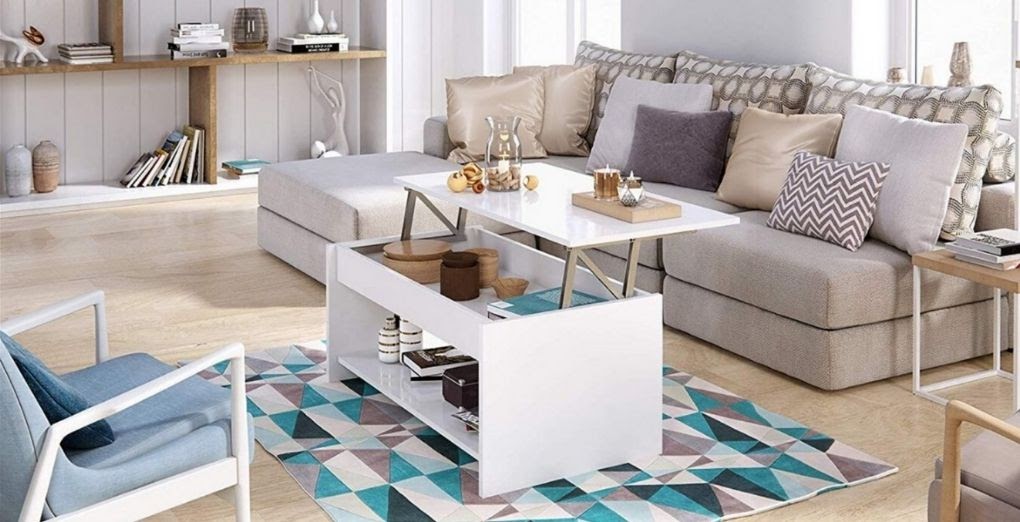
Because the majority of your potential clients will be young customers, they tend to prefer trendy and modern furniture, which is also practical and does not take much place. Indeed, China’s urbanization has grown at a faster pace during the last decade, and apartments are smaller and more expensive. Thus, if you are planning to sell modern, small, multifunctional, and innovative, you’ll be able to attract lots of consumers. Of course, you’ll need to develop your online presence as well as market effectively your products.
What are China’s Furnitures Trends?
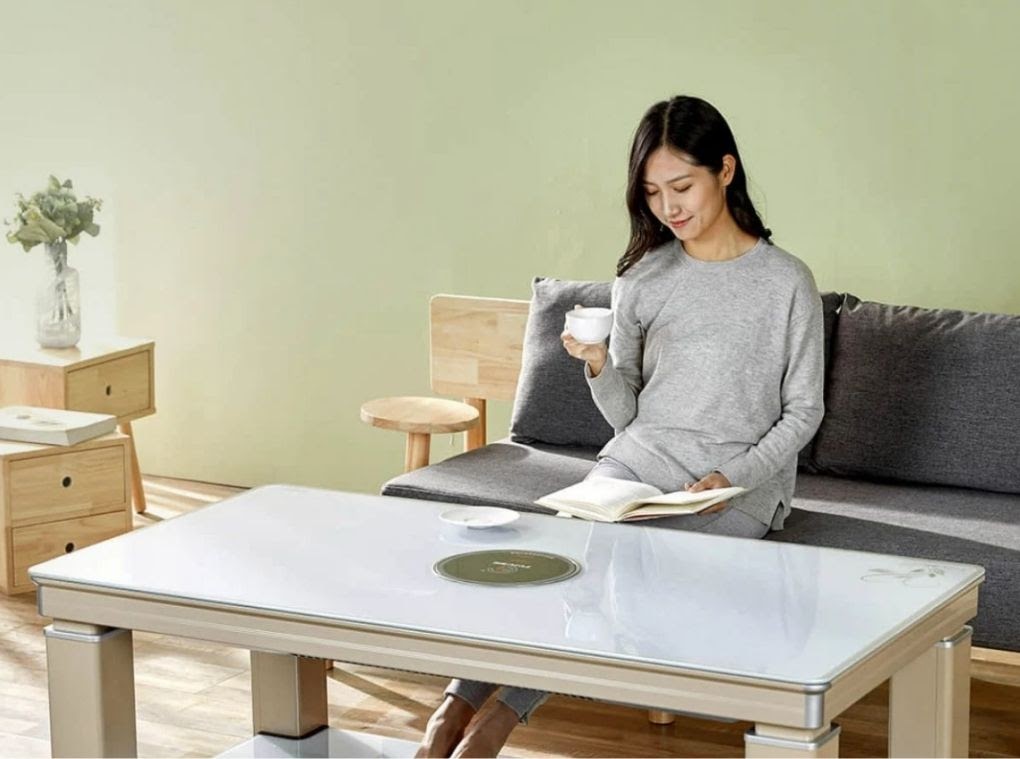
As you probably already know, Chinese consumers are connected all day long. Thus, the most promising sector in the furniture industry is ‘intelligent furniture’. For example in China, many people have an intelligent fridge, connected mirrors, etc. The smart home equipment market includes smart home devices and intelligent furniture. Many brands have already seized the opportunity, such as Huawei, Xiaomi, Baidu, and even JD.com.
Then, Chinese consumers are conscious of the necessity to preserve the environment, and an increasing number of them are searching for environmentally-friendly furniture, made from eco-friendly and natural materials. Cautious about their health, it is also recommended to avoid using chemical products on your furniture.

Moreover, if you are specialized in customed furniture, you have to know that Chinese consumers are increasingly interested in this kind of service and furniture. It is a way for them to distinguish themselves, foster their creativity, and have high-quality designed furniture. For example, you can add the possibility for Chinese consumers to customize their furniture directly through the e-commerce platform.
From where do Chinese consumers import the most furniture?
In the imported categories, American-style furniture takes the biggest part. It is suggested that the young generation who has strong purchasing power, prefer to buy American-style ones due to the influence of American movies, series, and lifestyles, so as nurtured in the American up-to-date trend and culture.
Diverse classifications of furniture products
Aside from its large population and the different kinds of consumers in China, the furniture market grows in a range of classifications in China. Not only does the home decorated furniture stands as the main figure but hotels, guesthouses, offices, outdoor furniture, and public institution furniture also share a big part of the massive market.
- Office furniture for Chinese growing service-economy
Driven by large-scale urbanization and China’s government strategy on infrastructure construction as well as house building, more and more offices are emerging. The high demand for office furniture is increasing as well, and some well-known companies, such as Johnson & Johnson and KPMG would like to reorganize their workplace by using modern design and functional furniture to a higher standard of better working environment and feelings for staff.
- Chinese Star-graded hotels drive high demand for high-end furniture
Another figure shows that Star-graded hotels are a major source of demand for upmarket furniture. Statistics showed that four-star hotel owns an average growth rate of 5.3% in China; likewise, five-star hotels grow at a 1.9% annual rate. In 2018, it is estimated that furniture replacement can hit 7.7 billion in four-star and five-star countries.
- China growing Children furniture’s market
An increasing number of furniture designed for children followed by lots of newborns and children aged under 15 years old, accounts for 250 million in 2017. Demand for children’s furniture is on the rise and is related to the high-quality living notion of Chinese consumers. According to young parents, it is important and essential to provide a safer and healthier environment for children. Among the many consideration factors in buying children furniture, the majority of parents would give priority to safety and the environment.
How to sell your furniture brand in China?
If you want to sell your furniture in China, you will need to look at the Chinese market and plan your marketing strategies beforehand. In fact, you will need to complete a long procedure in the majority of the cases, as well as prove the quality of your products and your motivation to enter the Chinese market.
The traditional method: Brick-and-mortar furniture stores

Displaying your furniture in brick-and-mortar stores is probably the first thing you’ll think of. As a matter of fact, brick-and-mortar stores were extremely popular among Chinese consumers looking for furniture and household equipment, particularly in specialized furniture malls.
However, during the Covid-19 lockdown, several companies such as the giant Ikea have focused their marketing strategies using virtual reality in their app or mini-programs, allowing consumers to visualize and compare all kinds of furniture directly from home.
Nevertheless, if you can afford to do so, you can still have your own store, as many Chinese consumers still prefer to talk and ask for advice when choosing their furniture. On the contrary to visualizing something online, they are able to touch it, measure it, open it, etc.
Our advice would be to first plan your marketing and advertising strategies, calculate the budget you’ll need to open a physical store, and also create at the same time an online store on Chinese e-commerce platforms. With all companies having specific needs and particularities, you can contact us to have more information, and our experts will help you according to your needs.
Chinese E-commerce platforms: A Must-have for furniture brands that want to make it in China
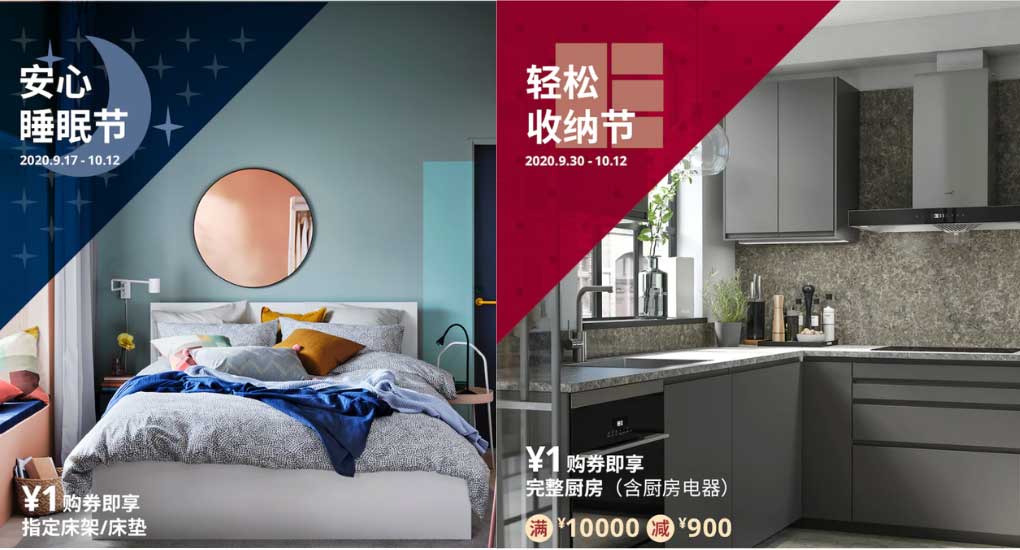
Following China’s rapid digitalization over the past decade, several e-commerce platforms were able to stand out in the Chinese market, grabbing over 782 million users as of 2020, and enabling this enormous spurt in China’s e-commerce sector.
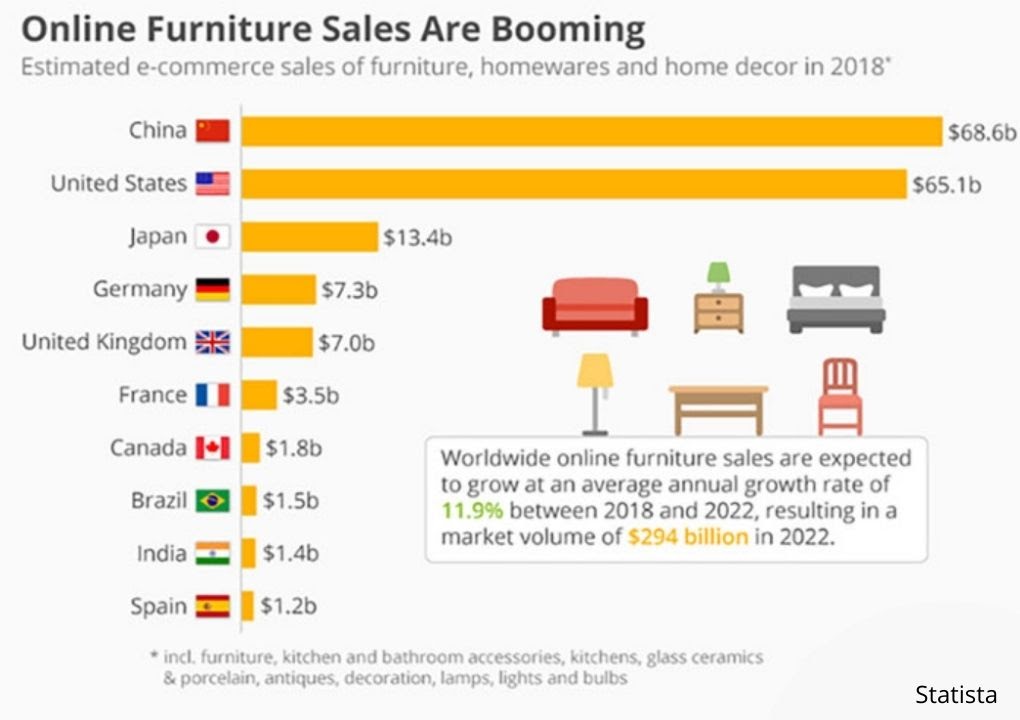
Online furniture is indeed booming in China, with $68.6 billion as of 2018. By 2021, the digital buyer penetration rate in China has edged close to 57%, propelling China to the second-largest e-tailing market after the U.S. As of 2020, the gross merchandise volume of online shopping in China has reached approximately 10.9 trillion yuan, with B2C e-commerce sales surpassing one trillion U.S dollars.

What’s impressive is that in just a decade China’s online shoppers grew from 160.51 million in 2010 to 782.41 million as of 2020. It is also important to underline that this number is expected to increase following the Covid-19 pandemic that has exacerbated this phenomenon.
The largest B2C e-commerce retailer in China in terms of gross merchandise volume (GMV) is Tmall. The B2C online retail platform operated by Alibaba Group generated a transaction volume of about 6.6 trillion yuan in 2020. The GMV of the leading C2C online retail platform Taobao.com (also operated by Alibaba Group), had reached almost 3.4 trillion yuan that year.
Sell your Furniture brand on Chinese e-commerce platforms
As mentioned earlier in this article, the furniture industry has grown exponentially in recent years. With a target audience mostly composed of younger consumers (especially the millennials), China’s digitalization has spurred app usage and e-commerce platforms. Even though traditional brick-and-mortar stores were still dominating the market for a long time, eCommerce sales of furniture are growing every year.
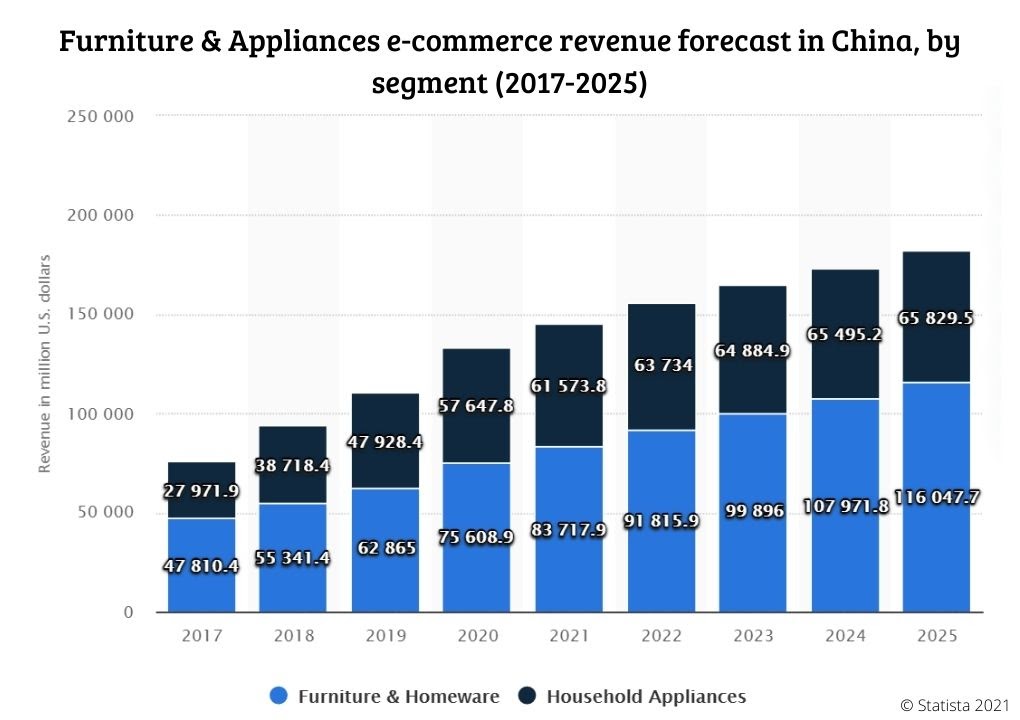
If we look at this graphic, we can see that the furniture and homeware segment online revenue in China is expected to reach US$116.047,7 million in 2025, compared to US$83 as of 2021.
- Tmall: The Leading B2C e-commerce platform in China
Founded in 2008 under the famous Alibaba group, Tmall (天猫), is a subsidiary of the e-commerce website Taobao (淘宝网). Its target market is primarily B2C (Business-To-Consumer). Tmall’s concept is ambitious and wise as it allows both local Chinese and international companies to sell their products through the platform in mainland China, Hong Kong, Macau, and Taiwan. Tmall stands out from its competitors thanks to its strict standards in terms of quality and renown.
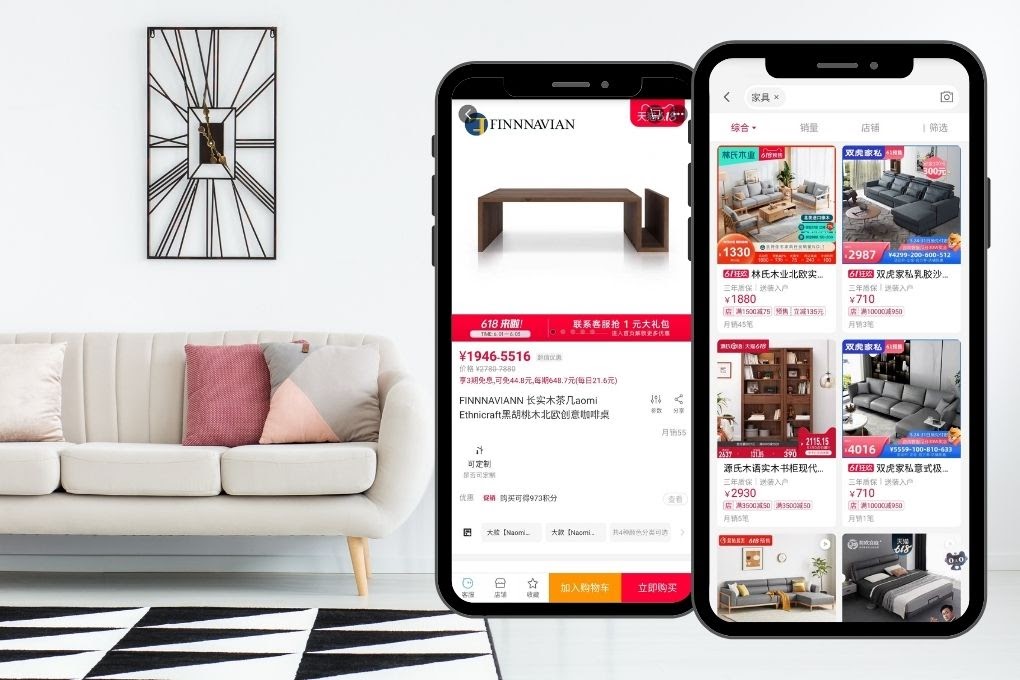
Over the years, Tmall was able to grab the majority of China’s e-commerce market shares, establishing itself as the most popular Chinese e-commerce website and becoming the best online gateway for local and international retailers. Thus, it can be a wonderful opportunity to sell your furniture through Tmall, opening an online shop directly on the platform.
Nonetheless, platforms like JD.com and Tmall only accept high-quality products and brands that already have a good reputation in China. Given all these conditions, it can be difficult to know which platform suits a company’s needs in terms of sales, audience, marketing, and even advertising. Before getting started, running a market survey is a great idea. It helps with understanding the potential of your furniture in China and defined a pricing & marketing strategy.
If you want more information on Tmall, you can check our Guide to Open a Tmall store
- JD.com: A major player in the e-commerce industry
Founded in 1998 by Liu Qiangdong in Beijing, JD (which stands for Jingdong 京东) was at the beginning only a magneto-optical store, which diversified over the years with electronics, computers, mobile phones, etc. In 2004, it opened its online retail platform and quickly became one of the two massive B2C online retailers in China with its competitor the Alibaba-run Tmall. Now, JD.com is partly owned by the giant Tencent, which has 20% of its stake. As of 2021, JD.com has over 470 million active customers.

JD.com has set its standards for online shopping through its commitment to quality, authenticity, and the variety of products it offers, covering everything from fresh food and apparel to electronics and cosmetics. Another asset of JD.com is the delivery time, which is, in general, the same day (or less than 24 hours).
Thus, JD.com is extremely popular among Chinese consumers looking for all kinds of products, which means that you’ll be able to reach a wide audience. However, take note that the application process takes time and that JD.com will look at the success of your brand, your funds, the quality of your products, your reputation, etc.
If you want to know more about JD.com, you can read our full Guide to Sell on JD.com
- Taobao: The Leading C2C platform in China
Launched in 2003 by the Chinese giant Alibaba, Taobao (淘宝网) is one of the most popular online shopping platforms, specializing in both B2C and C2C transactions, as well as the most popular online entrepreneurship platform, enabling thousands of young entrepreneurs to be successful. It has hundreds of millions of products and service listings, which are really appreciated by Chinese consumers. As of 2019, it has 300 million daily active users and 668 million mobile monthly active users. Taobao accounts for nearly 60% of the total e-commerce sales in China.
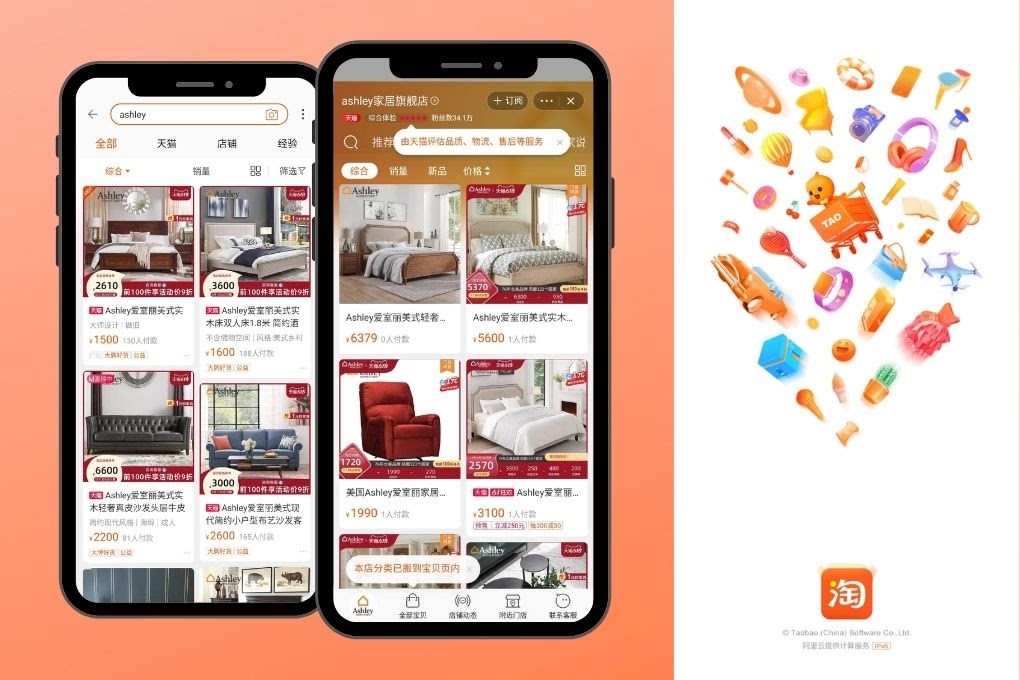
It can be extremely interesting to sell furniture in China as the process of application is not as strict as for Tmall and JD.com. Most of the brands selling on Taobao are able to enter the platforms without much difficulty if they are prepared enough. If you want to have more information about selling furniture on Taobao, do not hesitate to contact us directly and our experts will take care of the application process for you.
If you want more information about Taobao, you can read our Guide to Selling on Taobao for Beginners
How to promote your furniture in China?
As you probably already know, because of the ‘Great Firewall’, Chinese consumers are not able to use foreign social media such as Facebook, Twitter, Instagram, Snapchat, etc. Thus, this does not mean that they are disconnected from the virtual world! In fact, China has its own social sphere, with social media apps counting hundreds of millions of users.
The Chinese population is among the most connected in the world, and with a tech-savvy population, it is almost a necessity to be present on social media. When looking for foreign furniture, netizens will also do research about brands online. When hesitating between your brand and another, they will look at reviews, etc.
Convert your Target Audience on Wechat
Created by the Chinese company Tencent and released in 2011, WeChat, also known as Weixin (微信) in China, is the most used social media in China with over 1.2 billion users in 2022, far beyond Weibo

Worldwide, WeChat is one of the leading social networks, ranking sixth in terms of active user number, becoming a lucrative marketing platform with its plethora of different functionalities. Its success relies on the fact that Wechat was able to integrate almost all the features that made the success of the world’s most popular networks.
For example, one powerful and useful way to take advantage of WeChat is to create an H5 brochure that you’ll be able to share with your followers, and directly on your social media accounts. It is cost-effective, and people will be able to share it with their friends, like word-of-mouth.
Get Massive Views for your Furnitures Brand with Weibo
Launched in 2009 by the Chinese technology company Sina Corporation (新浪), Weibo (微博) is one of the biggest social media platforms in China. As its name indicates (“micro-blog”), Weibo provides micro-blogging services and is often compared to Twitter. However, it has evolved into a microblogging hybrid with Instagram, Pinterest, Reddit, and YouTube over the years.

As of 2021, Weibo has 56.8% of the Chinese microblogging market in terms of active users, and 86.6% in terms of browsing time over Chinese competitors such as Tencent and Baidu. It has more than 511 monthly active users and millions of posts per day, making it the largest Chinese-language mobile portal. Almost all Chinese millennials are using this social app in order to follow celebrities, KOLs, brands, read news, etc.
With the majority of foreign brands having an official account on Weibo, you will probably have to consider creating an official account on Weibo. To do so, you can contact us and our team will take care of it.
Having a Chinese website: The basics when entering the Chinese market
If you want to target Chinese consumers and sell your furniture in China, it is undeniable that you will need to create a website in Mandarin Chinese. In general, the first thing consumers will be looking at is your website. Indeed, they will enter your brand’s name on Baidu for example, then click on your website.
Don’t forget that you must adapt your website for smartphones, as the majority of the population uses its smartphone to do online research, on their way to work, or during lunch break. Moreover, it is essential to have a Chinese website if you want to rank on Baidu.

Baidu SEO: An opening window for the Chinese market
As the most popular search engine in China by far, Baidu simply is a step you can’t skip in China. However, increasing your website’s ranking on Baidu requires a slightly different way of thinking about Search Engine Optimization (SEO) compared to what you might be used to with Google.
Considered the “Chinese Google”, Baidu is the most popular Chinese Search Engine and stands as the 5th most consulted website in the world. As of 2021, it represents 71.9% of the Chinese market share.

Baidu is an opening window to enter the Chinese market as consumers will do their research on it in order to discover your brand. If you are not visible through the first pages,y you won’t probably get much traffic.
That’s why working on Baidu’s SEO is as important as setting up your e-commerce online shop. In order to do it successfully without wasting too much time, you can contact specialized experts such as GMA. We have helped many companies increase successfully their rank on Baidu, gaining much traffic, and thus, much more clients.
More about China Furnitures Market: The Leading Exporter and Importer Worldwide
For a long time, China was the leading exporter of goods in various industries, including furniture. After that, owing to its rapid industrialization, China attracted several international companies selling furniture, thanks to a growing demand for foreign furniture from Chinese consumers.
China: Manufacturer of the world

In 2004, China became the largest exporter of furniture in the world, exporting a major part of it overseas. Over the years, it has maintained an astonishing growth rate (17% between 2006 and 2016) and is mainly driven by the real estate industry. With more than 50,000 furniture manufacturers in China, the majority of them are small to medium companies, selling house furniture, or office furniture for example.
With China’s furniture industry increasing steadily, it already accounts for 39% of the world’s furniture production.
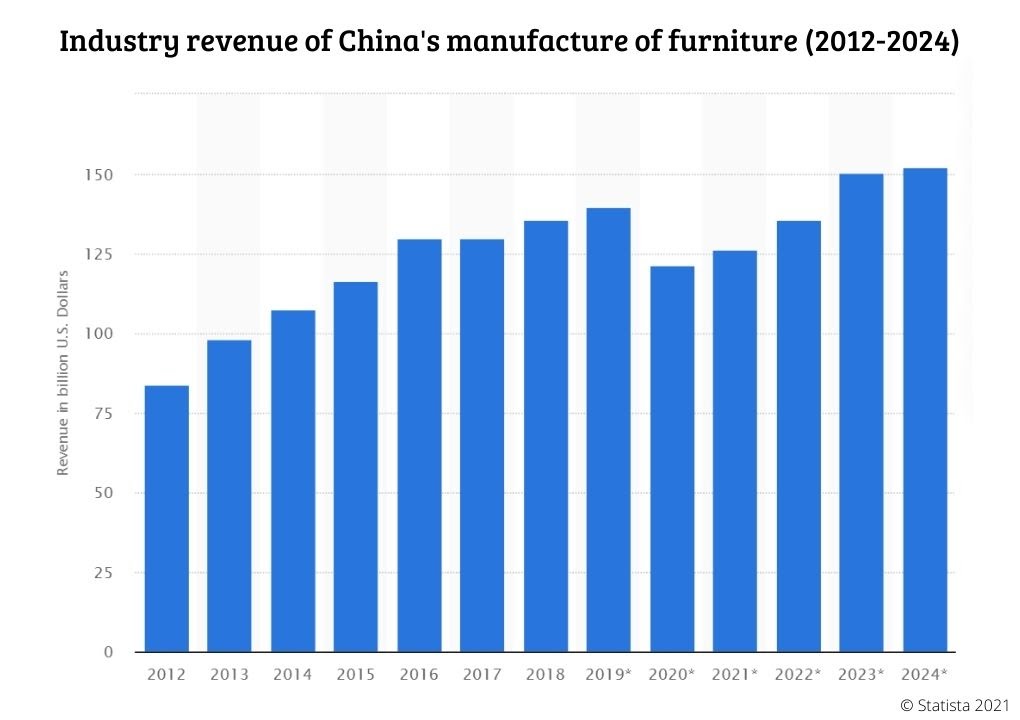
According to this graphic, the revenue of the manufacture of furniture in China is projected to amount to approximately 152,1 billion U.S. dollars by 2024.
Thus, China is not only counting on its population to increase its sales but also on exportations overseas.

In a decade, China’s China’s furniture exports abroad grew from 25.33 billion dollars to around 54.09 billion U.S. dollars.
The success of exported and imported furniture in China
Considered a furniture exporter giant in the industry, China has built a long reputable image in selling furniture to developed countries, especially the United States, an advantage of its affordable price and abundant variety of choices.
Except for manufacturing furniture for exportation, China has a large domestic market in home decoration and there are more and more local furniture manufacturers who want to share a piece of the pie. However, there is another trend, which is purchasing imported furniture due to the consumption upgrade of Chinese consumers.
For the sake of a premium lifestyle, higher quality of living experience, and aesthetic home decoration to convey a unique personal image, China turned out as a consumer market, attracting western and designer brands of furniture.
According to China’s Furnishing industry development report, finished furniture product has over 724 billion market scale, and custom-made furniture covers 235 billion shares and is expected to grow 15% every year afterward. The whole market is expected to reach 4 trillion of China’s domestic furniture and imported furniture is evaluated to reach 400 billion.
Contact us if you want to sell furniture in China
The Chinese market is one of the most promising in the world in terms of furniture, both for smaller companies like startups, but also for larger international companies. However, in order to succeed, you will need to use local e-commerce websites, and social media, have an online presence, adapt your marketing strategies to Chinese consumers, etc.
To do so, you will need to do a lot of research beforehand as well as be prepared to complete quite long procedures to sell your furniture in China. That’s why working with specialists in the Chinese market can be the key to success.

Working with an agency that has both western and Chinese points of view like Gentlemen Marketing Agency can help you overcome the pitfalls of the Chinese market. Our agency has accompanied many companies entering the Chinese market through e-commerce platforms and promoting their brand through Chinese social media.
Proud of the success of the companies that contacted us, our experts are ready to help any company willing to do business in China. So, if you are interested in doing business in China, do not hesitate to contact us and we will reply within 24 hours.








Realy great article, show how Chinese like imported stuff, and how proud they are when they buy imported brand.
IMported brand is better than imported products.